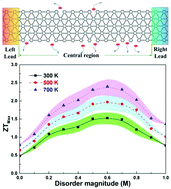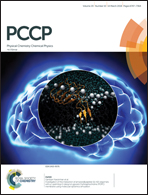Enhancing the thermoelectric performance of gamma-graphyne nanoribbons by introducing edge disorder†
Abstract
Structure disorder especially edge disorder is unavoidable during the fabrication of nanomaterials. In this paper, using the non-equilibrium Green's function method, we investigate the influence of edge disorder on the thermoelectric performance of gamma(γ)-graphyne nanoribbons (GYNRs). Our results show that the high Seebeck coefficient in pristine γ-GYNR could still be preserved although edge disorder is introduced into the structure. Meanwhile, in these edge-disordered nanoribbons the suppression of thermal conductance including electronic and phononic contributions outweighs the reduction of electronic conductance. These two positive effects combine together, and finally boost the thermoelectric conversion efficiency of γ-GYNRs. The thermoelectric figure of merit ZT in the edge-disordered γ-GYNRs (the length and width are about 55.68 and 1.41 nm) could approach 2.5 at room temperature, and can even reach as high as 4.0 at 700 K, which is comparable to the efficiency of conventional energy conversion methods. The findings in this paper indicate that the edge-disordered γ-GYNRs are a promising candidate for efficient thermoelectric energy conversion and thermal management of nanodevices.



 Please wait while we load your content...
Please wait while we load your content...